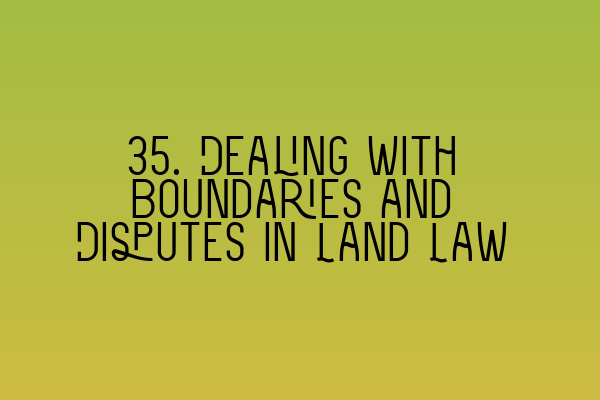Dealing with Boundaries and Disputes in Land Law
Boundaries play a crucial role in land ownership, providing clarity and defining the limits of each property. However, it is not uncommon for disputes to arise regarding these boundaries, causing friction between neighboring landowners. As a solicitor specializing in property law and land law, SQE Property Law & Land Law is here to guide you through the complexities of dealing with boundaries and resolving disputes. In this blog post, we will explore the key aspects of boundary disputes and provide you with valuable insights to navigate these challenging situations.
Understanding Boundaries
Boundaries are a fundamental concept in land law, serving as the demarcation lines between different parcels of land. They ensure that owners have exclusive access to and control over their properties. Boundaries can be defined in various ways, including physical features like fences, walls, or hedges, as well as natural boundaries such as rivers or cliffs. In many cases, boundaries are also described in legal documents like deeds or land registry records.
It is essential to understand that boundaries are not always straightforward and can be subject to interpretation and change over time. The accuracy and precision of boundary descriptions may vary, leading to potential disputes between landowners. These disputes can arise due to differences in perception, historic boundary alterations, or inadequate documentation.
Types of Boundary Disputes
Boundary disputes can take several forms, and each case is unique. However, some common types of boundary disputes include:
- Encroachment: This occurs when one landowner extends their property beyond the recognized boundary, either intentionally or unintentionally. It can happen through construction projects, erection of fences, or encroachment of buildings onto adjacent land.
- Discrepancy in Boundary Lines: Sometimes, the boundaries described in legal documents or depicted on maps may differ from the physical features on the ground. This can lead to confusion and disputes over the true boundary lines.
- Trespass: Trespassing involves unauthorized entry onto another person’s land, often due to a misunderstanding or confusion regarding the boundary lines. Trespass disputes can involve issues of rights of way, easements, or the use of shared spaces.
- Boundary Maintenance: Disputes may also arise over the responsibility for maintaining boundary features, such as fences or walls, as well as the cost-sharing arrangements between neighboring landowners.
Resolving boundary disputes can be complex and time-consuming, requiring a thorough understanding of land law principles, legal documentation, and evidence gathering. At SQE Property Law & Land Law, our team of experienced solicitors can assist you in navigating these challenges and advocating for your rights.
Steps to Resolve Boundary Disputes
When facing a boundary dispute, it is essential to follow a systematic approach to reach a fair and amicable resolution. Here are some steps that can help:
- Review Legal Documentation: Begin by carefully examining the relevant legal documents, such as deeds, conveyances, or land registry records, to understand the boundaries as defined on paper.
- Obtain Expert Advice: Engage the services of a property surveyor or land surveyor who can accurately determine the physical boundaries of the land. Their expertise and professional opinion can provide crucial evidence in support of your claim.
- Communication and Negotiation: Reach out to the neighboring landowner and try to engage in open and constructive discussions. Work towards finding a mutually acceptable solution through negotiation or mediation. A resolution through dialogue can save both time and costs compared to going to court.
- Alternative Dispute Resolution (ADR): If direct negotiation fails, consider alternative methods of dispute resolution, such as mediation or arbitration. ADR can offer a more flexible and less adversarial approach, helping both parties find common ground.
- File a Claim: If all else fails, and a resolution cannot be reached through non-legal means, you may consider filing a claim with the appropriate court. Your solicitor will guide you through the court proceedings, representing your interests and presenting your case.
It is important to note that litigation should be seen as a last resort. The costs, time, and emotional toll associated with court proceedings can often outweigh the benefits. Therefore, exploring alternative solutions and seeking legal advice early on is highly recommended.
Conclusion
Boundary disputes can be challenging, but with the right approach and professional guidance, they can be resolved efficiently and fairly. At SQE Property Law & Land Law, we are dedicated to assisting clients in navigating the complexities of property law and resolving boundary disputes effectively. Our experienced solicitors provide expert advice, practical solutions, and effective representation, ensuring your rights are protected throughout the process.
If you would like to know more about boundary disputes or any other aspects of property law and land law, feel free to explore our SQE 1 Practice Exam Questions or SQE 1 Practice Mocks FLK1 FLK2. You can also check out our comprehensive SQE 2 Preparation Courses and SQE 1 Preparation Courses to enhance your knowledge and skills. Stay informed about the latest SRA SQE Exam Dates to plan your study and examination schedule effectively.
Contact SQE Property Law & Land Law today and let our team of experts handle your boundary disputes with professionalism and efficiency.
